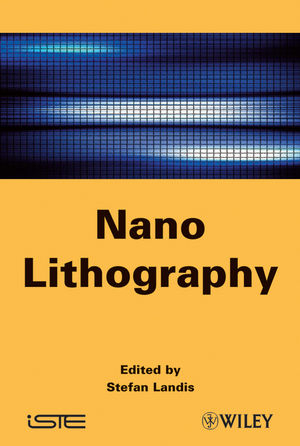
Nano Lithography
ISTE Ltd and John Wiley & Sons Inc (Verlag)
978-1-84821-211-4 (ISBN)
- Titel z.Zt. nicht lieferbar
- Versandkostenfrei innerhalb Deutschlands
- Auch auf Rechnung
- Verfügbarkeit in der Filiale vor Ort prüfen
- Artikel merken
Lithography is an extremely complex tool – based on the concept of “imprinting” an original template version onto mass output – originally using relatively simple optical exposure, masking, and etching techniques, and now extended to include exposure to X-rays, high energy UV light, and electron beams – in processes developed to manufacture everyday products including those in the realms of consumer electronics, telecommunications, entertainment, and transportation, to name but a few. In the last few years, researchers and engineers have pushed the envelope of fields including optics, physics, chemistry, mechanics and fluidics, and are now developing the nanoworld with new tools and technologies. Beyond the scientific challenges that are endemic in this miniaturization race, next generation lithography techniques are essential for creating new devices, new functionalities and exploring new application fields.
Nanolithography is the branch of nanotechnology concerned with the study and application of fabricating nanometer-scale structures − meaning the creation of patterns with at least one lateral dimension between the size of an individual atom and approximately 100 nm. It is used in the fabrication of leading-edge semiconductor integrated circuits (nanocircuitry) or nanoelectromechanical systems (NEMS).
This book addresses physical principles as well as the scientific and technical challenges of nanolithography, covering X-ray and NanoImprint lithography, as well as techniques using scanning probe microscopy and the optical properties of metal nanostructures, patterning with block copolymers, and metrology for lithography.
It is written for engineers or researchers new to the field, and will help readers to expand their knowledge of technologies that are constantly evolving.
Stefan Landis, CEA-LETI-Minatec, Grenoble, France.
Foreword xi
Jörge DE SOUSA NORONHA
Introduction xvii
Michel BRILLOUËT
Chapter 1. X-ray Lithography: Fundamentals and Applications 1
Massimo TORMEN, Gianluca GRENCI, Benedetta MARMIROLI and Filippo ROMANATO
1.1. Introduction 1
1.2. The principle of X-ray lithography 5
1.3. The physics of X-ray lithography 25
1.4. Applications 55
1.5. Appendix 1 79
1.6. Bibliography 79
Chapter 2. NanoImprint Lithography 87
Stefan LANDIS
2.1. From printing to NanoImprint 87
2.2. A few words about NanoImprint 90
2.3. The fabrication of the mold 96
2.4. Separating the mold and the resist after imprint: de-embossing 100
2.5. The residual layer problem in NanoImprint 118
2.6. Residual layer thickness measurement 132
2.7. A few remarks on the mechanical behavior of molds and flow properties of the nanoimprint process 148
2.8. Conclusion 157
2.9. Bibliography 157
Chapter 3. Lithography Techniques Using Scanning Probe Microscopy 169
Vincent BOUCHIAT
3.1. Introduction 169
3.2. Presentation of local-probe microscopes 170
3.3. General principles of local-probe lithography techniques 171
3.4. Classification of surface structuring techniques using local-probe microscopes 173
3.5. Lithographic techniques with polymer resist mask 179
3.6. Lithography techniques using oxidation-reduction interactions 185
3.7. “Passive” lithography techniques 198
3.8. Conclusions and perspectives 200
3.9. Bibliography 201
Chapter 4. Lithography and Manipulation Based on the Optical Properties of Metal Nanostructures 207
Renaud BACHELOT and Marianne CONSONNI
4.1. Introduction 207
4.2. Surface plasmons 208
4.3 Localized plasmon optical lithography 216
4.4. Delocalized surface plasmon optical lithography 222
4.5. Conclusions, discussions and perspectives 225
4.6. Bibliography 226
Chapter 5. Patterning with Self-Assembling Block Copolymers 231
Karim AISSOU, Martin KOGELSCHATZ, Claire AGRAFFEIL, Alina PASCALE and Thierry BARON
5.1. Block copolymers: a nano-lithography technique for tomorrow? 231
5.2. Controlling self-assembled block copolymer films 233
5.3. Technological applications of block copolymer films 237
5.4. Bibliography 244
Chapter 6. Metrology for Lithography 249
Johann FOUCHER and Jérôme HAZART
6.1. Introduction 249
6.2. The concept of CD in metrology 250
6.3. Scanning electron microscopy (SEM) 254
6.4. 3D atomic force microscopy (AFM3D) 266
6.5. Grating optical diffractometry (or scatterometry) 286
6.6. What is the most suitable technique for lithography? 310
6.7. Bibliography 316
List of Authors 321
Index 323
| Erscheint lt. Verlag | 14.1.2011 |
|---|---|
| Verlagsort | London |
| Sprache | englisch |
| Maße | 160 x 236 mm |
| Gewicht | 635 g |
| Themenwelt | Technik ► Elektrotechnik / Energietechnik |
| ISBN-10 | 1-84821-211-9 / 1848212119 |
| ISBN-13 | 978-1-84821-211-4 / 9781848212114 |
| Zustand | Neuware |
| Haben Sie eine Frage zum Produkt? |
aus dem Bereich


